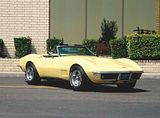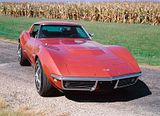| year by year |
1953 - 1962
First generation Corvette...


|
1963 - 1967
Second generation Corvette...


|
1968 - 1982
Third generation Corvette...


|
1984 - 1996
Fourth generation Corvette...


|
1997 - 2004
Fifth generation Corvette...


|
2005 - Present
Sixth generation Corvette...


|
Future
Seventh generation Corvette...


|
 |
|
| |
1968 Corvette
|
The 1968 Corvette would prove to be nearly as controversial as the times themselves. The so-called "Shark" generation was a very different sort of sports car than its predecessors -- what was a dual-purpose race-and-ride machine had evolved into more of a plush and powerful boulevard cruiser. Critics would blast the initial C3 offering for its excessive styling, increased bulk, and carryover platform -- it certainly was not the substantial leap forward Corvette fans had hoped for.
The third-generation Corvette suffered from development problems and introduction was postponed from 1967 to 1968. It was probably just as well. Although the government's first safety and emissions standards took effect nationwide with the '68 model year, Chevy would doubtless have seen to it that the engineering of an all-new 1967 model reflected the new standards. As it was, the delay took some of the pressure off of harried engineers.
As was the case with the first Sting Ray, powertrains for the new 1968 model were largely retained from the previous generation. The one significant exception was substitution of GM's new three-speed Turbo Hydra-Matic transmission for the old two-speed Powerglide automatic. Elsewhere, the car's battery was relocated behind the seats to improve weight distribution and to provide added under-hood room. Side vent windows were eliminated in favor of a new fresh-air "Astro Ventilation" system. Shoulder belts, previously an added-cost option, were included at no charge on coupes. Other new features for 1968 accentuated the Corvette's GT leanings, and included an electric rear-window defroster, speed warning indicator, AM/FM stereo radio, and a futuristic fiber-optic light monitoring system.
Higher spring rates were calculated to reduce fore/aft pitching, especially under hard acceleration. This also served to lower the rear roll center and was nicely complemented by newly standard seven-inch-wide wheels, an inch broader than before, wearing low-profile F70 × 15 tires. With these modifications and the resulting wider track dimensions (now 58.7/59.4 inches front/rear), the 1968 Corvette hugged the pavement even better than the Sting Ray, though at the expense of a perceptibly harsher ride.
To many, the 1968 Corvette's styling was excessive and bloated (its weight had ballooned by some 150 pounds), and the car was criticized for abandoning its sports-car purity. The car was also given low marks in the press for its scarce luggage space, awkward ingress/egress, and poor instrument placement, and reviewers found the car's new interior ventilation system to be lacking. The Corvette's fit and finish and overall build quality were judged to be abysmal, and even the new T-top was greeted with lukewarm response.
Still, the motoring press thought highly of the latest Corvette's straight-line performance, though some felt the big 435-horsepower 427 was too brutish a beast, though the 300- and 350-bhp small-blocks impressed as much as ever. The Muncie four-speed manual transmission and the new Turbo Hydra-Matic also garnered praise. As for handling, the press seemed to like the skidpad and slalom numbers they got but not the way the car felt generating them. Several complaints were made about the harder ride, and nobody much liked the power steering and brakes.
Despite its flaws, the 1968 Corvette remained an exhilarating ride. It had plenty of power even in small-block form, and its all-independent suspension, if not exactly state-of-the-art, was certainly more than adequate. Testing a 350-bhp 327 roadster with the four-speed and 3.70:1 final drive, Road & Track reported a top speed of 128 mph, a standing quarter-mile of 15.6 seconds at 92 mph, and 0-60-mph acceleration of 7.7 seconds. Fuel economy, however, was pegged at 11-15 mpg for a cruising range of only 220-300 miles from the 20-gallon tank. Big-block cars were even thirstier -- but faster, of course. Car and Driver, running a 400-bhp 427 coupe, hit 60 mph in 5.7 seconds and posted a 14.1-second quarter mile at a blazing 102 mph.
The car's paltry cruising range couldn't really be considered as much of a liability, however, since with only 6.7 cubic feet of cargo space available, the car wasn't exactly outfitted for long-distance driving. Further, a newly tighter cabin included accordingly tighter seats with fixed backrests raked much farther back than in the Sting Ray to accommodate the Shark's two-inch lower roofline. The resulting laidback stance conspired with a high cowl to give the impression of being in a bathtub. A long, low nose that disappeared somewhere near the horizon made parallel parking an adventure.
Yet for all the problems and poor reviews, more people bought Corvettes than ever before; model-year sales set a new record at 28,566 units, some 5,000 up on the final Sting Ray. Part of this was due to prices that remained competitive at $4,320 for the ragtop and $4,663 for the coupe.
Reflecting its popularity, the new Corvette was chosen Best All-Around Car in Car and Driver's annual reader's poll (the 1967 Sting Ray had been likewise honored), as well as Best Sports/GT Car Over 3000cc.
|






|
1968 Corvette Specifications
The 1968 Corvette marked the introduction of the "Shark," a longer, meaner boulevard cruiser. Though the handling was rough and Corvette still had some kinks to work out, the car was powerful and exhilarating to drive. Here are the specifications for the 1968 Corvette Shark:
Vehicle Specifications
|
Convertible
|
Coupe |
Wheelbase, inches
|
98.0
|
98.0 |
Length, inches
|
182.1
|
182.1 |
Width, inches
|
69.2
|
69.2 |
Track, inches
|
front: 58.3 rear: 59.0
|
front: 58.3 rear: 59.0 |
Height, inches
|
47.8
|
47.8 |
Curb weight, pounds
|
3,425
|
3,260 |
Mechanical Specifications (2-door convertible/coupe)
Suspension
front:Independent; upper and lower A-arms, coil springs, tubular hydraulic shock absorbers, antiroll bar
rear: Independent, lateral leaf springs, struts, U-joint halfshafts, trailing arms, tubular hydraulic shock absorbers
Wheels/Tires
7x15
Brakes
front: 11.75-inch disc
rear: 11.75-inch disc
Transmission
3-speed manual (std)
4-speed manual (opt)
3-speed Hydra-Matic (opt)
Standard axle ratio
3.70:1
Engine Specifications
| Type |
ohv V-8
|
ohv V-8
|
ohv V-8
|
ohv V-8
|
ohv V-8
|
ohv V-8
|
Displacement, liters/cu inch
|
5.35/327
|
5.35/327
|
7.0/427
|
7.0/427
|
7.0/427
|
7.0/427
|
Bore × stroke, inches
|
4.00 x 3.25 |
4.00 x 3.25 |
4.25 x 3.76 |
4.25 x 3.76 |
4.25 x 3.76 |
4.25 x 3.76 |
Fuel Management
|
1 x 4-bbl.
|
1 x 4-bbl. |
1 x 4-bbl. |
3 x 2-bbl. |
3 x 2-bbl. |
1 x 4-bbl. |
Horsepower @ rpm
|
300 @ 5,000 |
350 @ 5,800 |
390 @ 5,400 |
400 @ 5,400 |
435 @ 5,800 |
430 @ 5,200 |
Torque @ rpm, pound-foot
|
360 @ 3,400 |
360 @ 3,600 |
460 @ 3,600 |
460 @ 3,600 |
460 @ 4,000 |
450 @ 4,400 |
Published Performance Numbers
Acceleration
|
300 hp, 4-sp man. |
0-60 mph, sec
|
6.5 |
0-100 mph, sec
|
NA |
1/4-mile, sec @ mph
|
13.41 @ 109.5 |
Vehicle Production and Base Prices
Car Type
|
Production
|
Price |
2-door convertible
|
18,630
|
$4,320.00 |
2-door coupe
|
9,936 |
4,663.00 |
Options and Production
Option
|
Production
|
Price |
Leather Seats
|
2,429
|
$79.00 |
Soft Ray Tinted Glass, all
|
17,635
|
15.80 |
Soft Ray Tinted Glass, windshield
|
5,509
|
10.55 |
| Power Windows |
7,065
|
57.95 |
Headrests
|
3,197
|
42.15 |
Custom Shoulder Belts (std w/coupe)
|
350
|
26.35 |
Auxiliary Hardtop
|
8,735
|
231.75 |
Vinyl Covering
|
3,050
|
52.70 |
Rear Window Defroster
|
693
|
31.60 |
Air Conditioning
|
5,664
|
412.90 |
Special Front and Rear Suspension
|
1,758
|
36.90 |
Positraction Rear Axle, all ratios
|
27,008
|
46.35 |
Power Brakes
|
9,559
|
42.15 |
Special Heavy Duty Brakes
|
81
|
384.45 |
Transistor Ignition System
|
5,457
|
73.75 |
390 hp Engine
|
7,717
|
200.15 |
400 hp Engine
|
1,932
|
305.50 |
435 hp Engine
|
2,898
|
437.10 |
350 hp Engine
|
9,440
|
105.35 |
430 hp Engine
|
80
|
947.90 |
Aluminum Cylinder Heads for L71
|
624
|
805.75 |
| 4-speed Manual Transmission |
10,760
|
184.35 |
4-speed Manual Transmission, close ratio
|
12,337
|
184.35 |
4-speed Manual Transmission, close ratio, heavy duty
|
80
|
263.30 |
Turbo Hydra-Matic Automatic Transmission
|
5,063
|
226.45 |
Off Road Exhaust System
|
4,695
|
36.90 |
Telescopic Steering Column
|
6,477
|
42.15 |
Power Steering
|
12,364
|
94.80 |
Bright Metal Wheel Cover
|
8,971
|
57.95 |
Red Stripe Tires, F70 x 15 nylon
|
11,686
|
31.30 |
White Stripe Tires, F70 x 15 nylon
|
9,692
|
31.30 |
Alarm System
|
388
|
26.35 |
Speed Warning Indicator
|
3,453
|
10.55 |
| AM/FM Radio |
24,609
|
172.75 |
AM/FM Radio, stereo
|
3,311
|
278.10 |
Color Choices and Production
Color Choice
|
Production |
Color Choice
|
Production |
| Tuxedo Black |
708
|
Polar White |
1,868 |
| Rally Red |
2,918
|
LeMans Blue
|
4,722 |
International Blue
|
2,473
|
British Green
|
4,779 |
Safari Yellow
|
3,133
|
Silverstone Silver
|
3,435 |
Cordovan Maroon
|
1,155
|
Corvette Bronze
|
3,374 |
|
|
|
|
